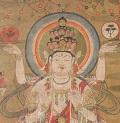GALLERY 2740 | EAST ASIAN BUDDHIST ART
 Introduced to China in the first century, Buddhism promised its adherents ultimate escape from existential suffering. It also offered ritual techniques for achieving present-world benefits, such as military victory and relief from disease. Treating both immediate and ultimate ills, Buddhism was already flourishing in China by the fourth and fifth centuries, when it was transmitted to Korea and Japan. By the seventh century, with the advent of the Tang dynasty (618–907), the era of China’s greatest openness to the Central Asian cultures of the Silk Road, Buddhism became the de facto state religion, receiving patronage from all social classes. As the mural fragments and sculptures on display in this gallery demonstrate, Chinese Buddhist art reached its peak of grace and refinement in this period.
Introduced to China in the first century, Buddhism promised its adherents ultimate escape from existential suffering. It also offered ritual techniques for achieving present-world benefits, such as military victory and relief from disease. Treating both immediate and ultimate ills, Buddhism was already flourishing in China by the fourth and fifth centuries, when it was transmitted to Korea and Japan. By the seventh century, with the advent of the Tang dynasty (618–907), the era of China’s greatest openness to the Central Asian cultures of the Silk Road, Buddhism became the de facto state religion, receiving patronage from all social classes. As the mural fragments and sculptures on display in this gallery demonstrate, Chinese Buddhist art reached its peak of grace and refinement in this period.
While early East Asian Buddhists primarily worshipped the historical Buddha Shakyamuni, later devotees turned their attention to the myriad buddhas (fully awakened beings) and bodhisattvas (awakened beings that choose, out of compassion, to remain in our world to alleviate the suffering of the unenlightened) of Mahayana Buddhism, leading to the production of ever more diverse images. The cults of bodhisattvas, such as Avalokiteshvara, and of Amitabha Buddha, whose Western Pure Land was a paradise that offered the ideal conditions for attaining awakening, found particular favor. Through sophisticated combinations of architecture, painting, sculpture, metalwork, and even garden design, worshippers throughout East Asia sought to create virtual Pure Lands within the spaces of their temples.




